A Guide to the Roots and Tubers You Didn’t Know You Loved
What’s this starchy potato-like root thing? We’re here to tell you.
A Guide to the Roots and Tubers You Didn’t Know You Loved
What’s this starchy potato-like root thing? We’re here to tell you.
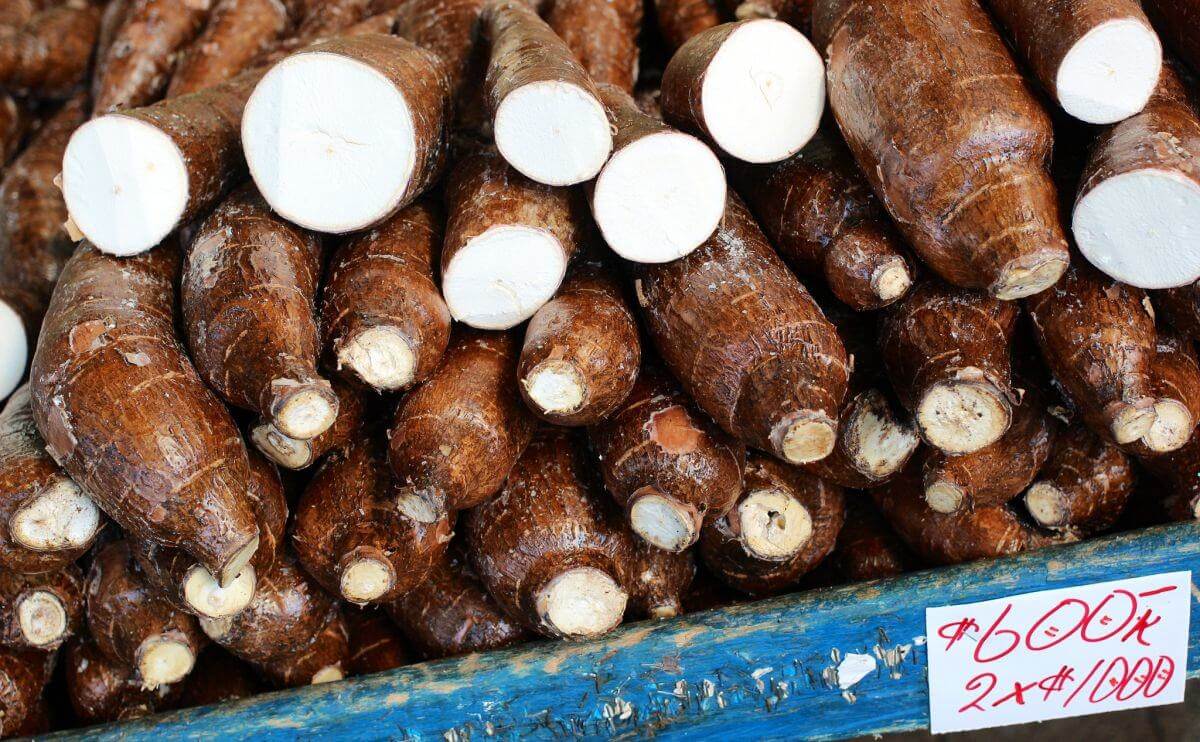
Potato
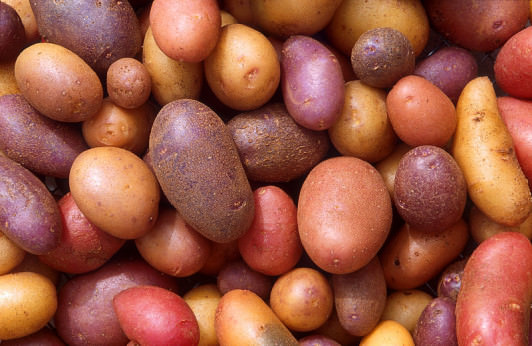
Perhaps the most common in the US, the potato is native to the Americas and comes in a variety of sizes, shapes, textures, and colors. Potatoes should not be eaten raw, but can be cooked in … you know what, we don’t need to do this. You all know what a potato is.
Sweet Potato

The sweet potato is a much more interesting plant than it’s given credit for. It’s not closely related to the potato, despite the similar name, area of origin, and general appearance; it comes from an entirely different family. Unlike the potato, the entire sweet potato plant is edible, from the leaves and flowers to the vines. It comes in a bunch of different colors – orange is the most common here in the US, but white, yellow, and deep red are also available. With much higher sugar and sodium content than the potato, sweet potatoes are used in both sweet and savory dishes all around the world.
Yam
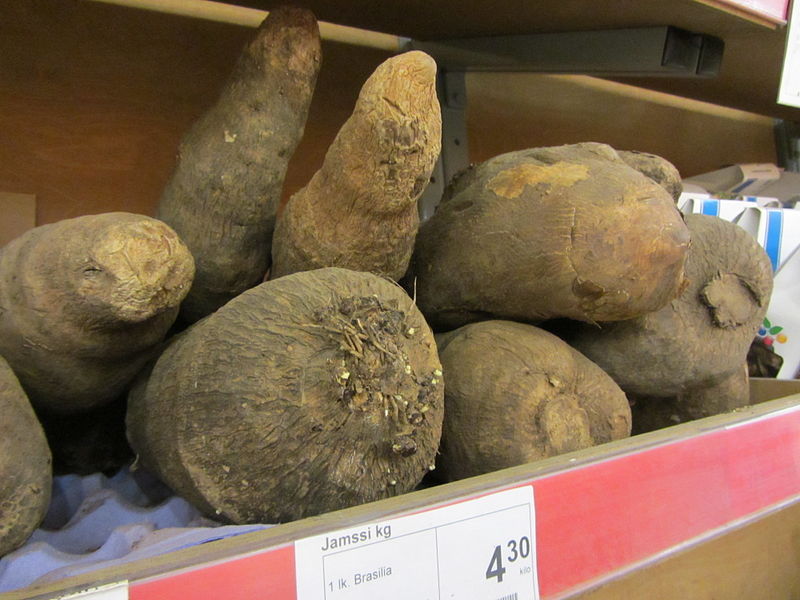
Ah ha, wait a second. Did you think yams and sweet potatoes were related, or different names for the same plant? Nope: They’re totally different. Yams are native to Africa, while sweet potatoes are native to the Americas. The two got all mixed up probably because of the slave trade: African slaves, upon seeing the American sweet potato, called it by the name of a plant they were used to (the yam). And Americans for centuries after have been confusing the two.
Yams are not all that common in the US; most things labeled “yam” – canned yams, yams with marshmallows – are the orange-fleshed sweet potato. (However, the USDA does require that products sold as canned yams must indicate on the label that they’re actually sweet potatoes.) A true yam looks very different: They’re often white-fleshed with dark, bark-like skin, and they also grow much, much bigger than sweet potatoes. Your best bet for finding a true yam in the US is at an ethnic market: West African, Asian, or Caribbean.
Plus: How to store root crops for winter
In Japan, the mountain yam (nagaimo), a variety with knobby beige skin, with white flesh, is typically grated into a mucilaginous goop and used as a binding agent. In the Philippines, purple yam is used in all manner of desserts, from shaved ice dishes to cakes. In Africa, it’s cooked much like a potato: boiled, fried, or baked and used as an essential starch.
Cassava

Hoo boy, another mess of names for this one. The cassava is a long, tapered, often shiny brown-skinned root that’s usually white on the inside. It’s native to the Americas yet again; possibly in Brazil, though it’s been exported to basically the entire equatorial world and is an essential starch all over the world.
Its names can be confusing. It is correctly known as the cassava, manioc, or yuca, but is often referred to as yucca. This is not really correct; the Spanish word for the plant is yuca (note the spelling, though the pronunciation is the same), due, probably, to some early linguistic confusion between the cassava (yuca) plant and the true yucca, an ornamental cactus-looking plant common in the Southwest. Another bit of confusion: When processed, the root of the cassava is known as tapioca. In the US, tapioca is most associated with a pudding filled with little gooey balls; those balls are, traditionally, made of dried and powdered cassava. But the tapioca powder is used for all sorts of other stuff, including flatbreads, desserts, and snacks.
Cassava is most often seen in West Africa, where, after it was introduced by Portuguese traders, a mash of boiled cassava became the primary calorie source for many countries. It’s known as fufu, and it takes the place of rice, corn, or wheat.
Taro
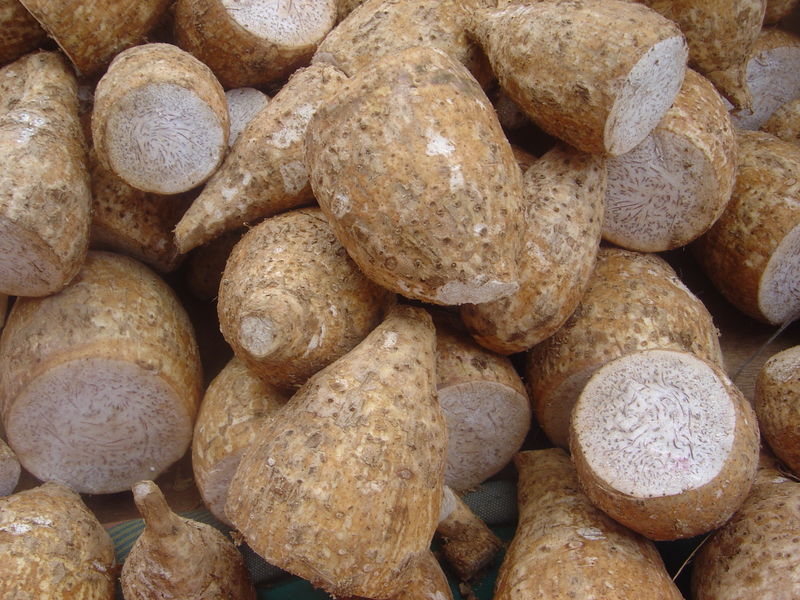
Taro is not technically a root nor a tuber; the part most commonly eaten is botanically a corm, meaning a thickened underground stem that’s used by the plant to store nutrients. The plant itself is most recognizable by its absurdly large leaves, sometimes known as elephant ear leaves. It’s most popular in the Pacific, ranging from China in the west through to the islands with which it might be most associated, Hawaii.
The corms of the taro are fairly high in carbohydrates, with a mild nutty flavor. It’s eaten, typically, much like a potato, either boiled, baked, or fried, and is very commonly sliced thinly and fried like potato chips. It’s used in many different ways in Hawaii, but it’s perhaps most known as the base of poi, a starchy, thick concoction made of boiled taro, fairly similar to fufu.
A variation is known as eddo or eddoe, and is common to the cuisines of the Caribbean.
Sunchoke
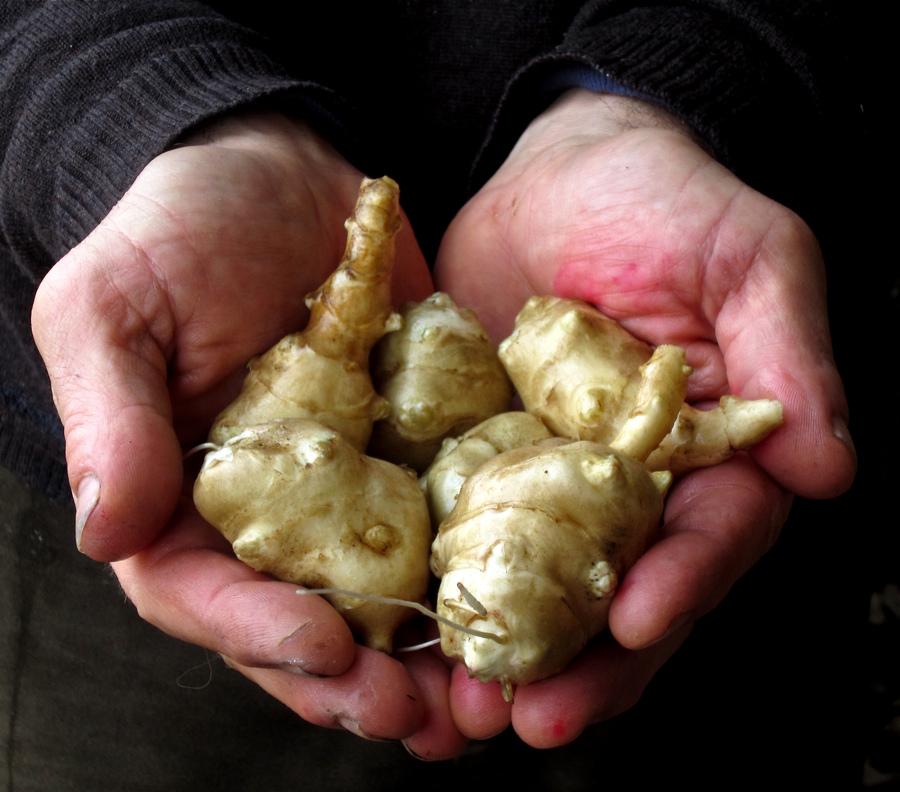
The sunchoke is sometimes known as the Jerusalem artichoke, which is wrong for two main reasons: It’s not from Jerusalem (it’s native to North America), and it’s totally unrelated to the artichoke. In fact, it’s the root of a member of the sunflower family. Naming aside, the sunchoke is an unusual and delicious root.
Plus: How to plant root vegetables in the fall
The sunchoke looks like a knobbly, brown-and-tan knuckle, something like a cross between a walnut and a potato. But it’s unusual for a tuber in that it can (and should!) be eaten raw, with a crisp texture and sweet flavor something like a water chestnut or jicama. When it’s cooked, it’s usually boiled or roasted, and can be treated basically like a potato.
Lotus Root
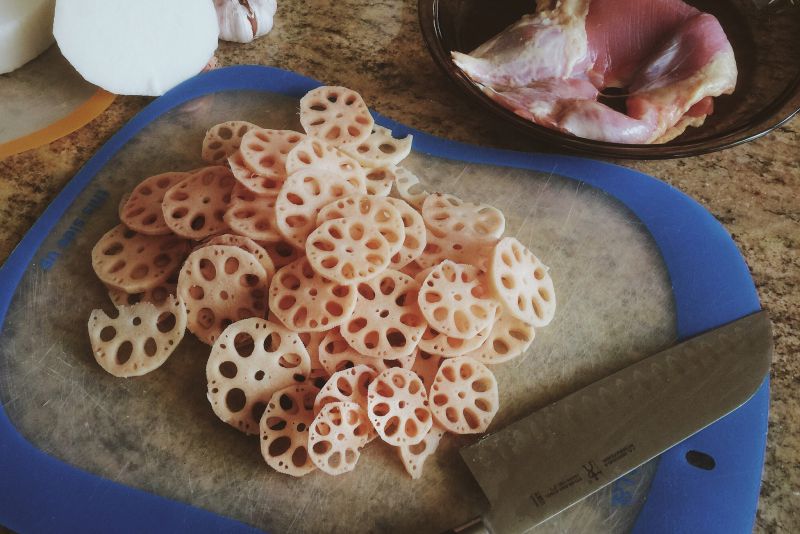
Instantly recognizable by its hole-filled structure, lotus root – like ginger – is actually a rhizome rather than a root or a tuber. It’s an aquatic plant, like a water lily, and the edible rhizome is usually sliced in rounds to preserve its pretty design. It’s kind of starchy and has a mild taste, but is common throughout Asia (both East and South) when boiled or steamed, and sometimes roasted, pickled, candied, or fried.
YautÁa

Sometimes also known as malanga or tannia, yautÁa is a hairy brown-skinned root that’s kind of rounded on top and elongates into a blunted point, like a cross between a beet and a carrot. On the inside, it’s most commonly white or a light yellow.
It’s very popular in the Caribbean, especially Trinidad, Cuba, Puerto Rico, and the Dominican Republic, which means that areas of the US with heavy influences from those islands (like Miami and New York City) are also laden with the roots. They’re sometimes boiled like potatoes, but in Puerto Rico are often used to make alcapurrias, a sort of football-shaped fritter made of fried yautÁa surrounding an interior of, usually, spiced ground beef. The leaves are also commonly used in callaloo, a dish of stewed greens.
Follow us

This work is licensed under a Creative Commons Attribution-NoDerivatives 4.0 International License.
Want to republish a Modern Farmer story?
We are happy for Modern Farmer stories to be shared, and encourage you to republish our articles for your audience. When doing so, we ask that you follow these guidelines:
Please credit us and our writers
For the author byline, please use “Author Name, Modern Farmer.” At the top of our stories, if on the web, please include this text and link: “This story was originally published by Modern Farmer.”
Please make sure to include a link back to either our home page or the article URL.
At the bottom of the story, please include the following text:
“Modern Farmer is a nonprofit initiative dedicated to raising awareness and catalyzing action at the intersection of food, agriculture, and society. Read more at <link>Modern Farmer</link>.”
Use our widget
We’d like to be able to track our stories, so we ask that if you republish our content, you do so using our widget (located on the left hand side of the article). The HTML code has a built-in tracker that tells us the data and domain where the story was published, as well as view counts.
Check the image requirements
It’s your responsibility to confirm you're licensed to republish images in our articles. Some images, such as those from commercial providers, don't allow their images to be republished without permission or payment. Copyright terms are generally listed in the image caption and attribution. You are welcome to omit our images or substitute with your own. Charts and interactive graphics follow the same rules.
Don’t change too much. Or, ask us first.
Articles must be republished in their entirety. It’s okay to change references to time (“today” to “yesterday”) or location (“Iowa City, IA” to “here”). But please keep everything else the same.
If you feel strongly that a more material edit needs to be made, get in touch with us at [email protected]. We’re happy to discuss it with the original author, but we must have prior approval for changes before publication.
Special cases
Extracts. You may run the first few lines or paragraphs of the article and then say: “Read the full article at Modern Farmer” with a link back to the original article.
Quotes. You may quote authors provided you include a link back to the article URL.
Translations. These require writer approval. To inquire about translation of a Modern Farmer article, contact us at [email protected]
Signed consent / copyright release forms. These are not required, provided you are following these guidelines.
Print. Articles can be republished in print under these same rules, with the exception that you do not need to include the links.
Tag us
When sharing the story on social media, please tag us using the following: - Twitter (@ModFarm) - Facebook (@ModernFarmerMedia) - Instagram (@modfarm)
Use our content respectfully
Modern Farmer is a nonprofit and as such we share our content for free and in good faith in order to reach new audiences. Respectfully,
No selling ads against our stories. It’s okay to put our stories on pages with ads.
Don’t republish our material wholesale, or automatically; you need to select stories to be republished individually.
You have no rights to sell, license, syndicate, or otherwise represent yourself as the authorized owner of our material to any third parties. This means that you cannot actively publish or submit our work for syndication to third party platforms or apps like Apple News or Google News. We understand that publishers cannot fully control when certain third parties automatically summarize or crawl content from publishers’ own sites.
Keep in touch
We want to hear from you if you love Modern Farmer content, have a collaboration idea, or anything else to share. As a nonprofit outlet, we work in service of our community and are always open to comments, feedback, and ideas. Contact us at [email protected].by Dan Nosowitz, Modern Farmer
January 6, 2016
Modern Farmer Weekly
Solutions Hub
Innovations, ideas and inspiration. Actionable solutions for a resilient food system.
ExploreExplore other topics
Share With Us
We want to hear from Modern Farmer readers who have thoughtful commentary, actionable solutions, or helpful ideas to share.
SubmitNecessary cookies are absolutely essential for the website to function properly. This category only includes cookies that ensures basic functionalities and security features of the website. These cookies do not store any personal information.
Any cookies that may not be particularly necessary for the website to function and are used specifically to collect user personal data via analytics, ads, other embedded contents are termed as non-necessary cookies.
The Malanga looks a lot like a root in Panama called Name(little squiggle above N). It is the main ingredient other than chicken, in their national dish-Sancocho. I can’t get it up here in Canada though, darn it…
Keep up the great work educating the consumers.
Thank you, this was very informative and useful
Ñame is long and skinny like yuca but not as starchy or as firm as yuca. Malanga is shaped more like a potato but with stickiness when you peel it like yuca. But I can’t find anyone who knows what ñame is. I had it in Colombia
Was told that water Lillie roots were boiled and eaten like potato.
True????
What is ñame? Is it keto friendly?